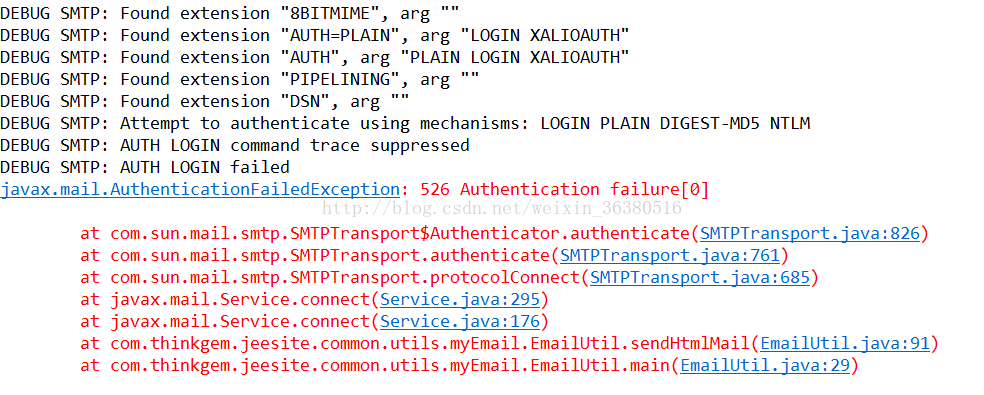一、配置
在Syn.properties进行邮箱host等配置
smtpServer=smtp.amuxia.com
fromUserName=邮箱的用户名
fromUserPassword=你的密码
#注意如果是企业邮箱需要smtp.企业的域名 比如我的域名是amuxia.com(当然这个也是假的,举个例子,哈哈)
如果是个人邮箱就是 smtpServer=smtp.aliyun.com
如果是企业邮箱不用域名的话,运行就会报错

二、设置取读配置文件的类EmailInfo
public class EmailInfo {
private String smtpServer;
// SMTP服务器地址
private String port; // 端口
private String username;
// 登录SMTP服务器的用户名,发送人邮箱地址
private String password;
// 登录SMTP服务器的密码
public EmailInfo() {
String path=this.getClass().getClassLoader().getResource(".").getPath()+"Syn.properties";
ConfigurationFile config = new ConfigurationFile(path);
this.smtpServer = config.getValue("smtpServer");
//this.port = config.getValue("port");
this.username = config.getValue("fromUserName");
this.password = config.getValue("fromUserPassword");
}
public String getSmtpServer() {
return smtpServer;
}
public void setSmtpServer(String smtpServer) {
this.smtpServer = smtpServer;
}
public String getPort() {
return port;
}
public void setPort(String port) {
this.port = port;
}
public String getUsername() {
return username;
}
public void setUsername(String username) {
this.username = username;
}
public String getPassword() {
return password;
}
public void setPassword(String password) {
this.password = password;
}
}
三、编写发送邮件的工具类 EmailUtil
public class EmailUtil {
private static Logger log = Logger.getLogger(EmailUtil.class);
public void send(String to[], String cs[], String ms[], String subject,
String content, String fileList[]) {
try {
final String SSL_FACTORY = "javax.net.ssl.SSLSocketFactory";
Properties p = new Properties();
EmailInfo info=new EmailInfo();
p.put("mail.debug", "true");
p.put("mail.smtp.host", info.getSmtpServer());
p.put("mail.smtp.ssl.enable", "true");
p.put("mail.smtp.socketFactory.class", SSL_FACTORY);
p.put("mail.smtp.port", "465");
p.put("mail.smtp.socketFactory.port", "465");
// props.put("mail.smtp.socketFactory.fallback", "false");
p.put("mail.smtp.auth", "true");
// 建立会话
// Session session = Session.getInstance(p);
Session session = Session.getDefaultInstance(p,
new Authenticator() {
protected PasswordAuthentication getPasswordAuthentication() {
return new PasswordAuthentication(info.getUsername(), info.getPassword());
}
});
Message msg = new MimeMessage(session); // 建立信息
BodyPart messageBodyPart = new MimeBodyPart();
Multipart multipart = new MimeMultipart();
msg.setFrom(new InternetAddress(info.getUsername())); // 发件人
String toList = null;
String toListcs = null;
String toListms = null;
// 发送,
if (to != null) {
toList = getMailList(to);
InternetAddress[] iaToList = new InternetAddress()
.parse(toList);
msg.setRecipients(Message.RecipientType.TO, iaToList); // 收件人
}
// 抄送
if (cs != null) {
toListcs = getMailList(cs);
InternetAddress[] iaToListcs = new InternetAddress()
.parse(toListcs);
msg.setRecipients(Message.RecipientType.CC, iaToListcs); // 抄送人
}
// 密送
if (ms != null) {
toListms = getMailList(ms);
InternetAddress[] iaToListms = new InternetAddress()
.parse(toListms);
msg.setRecipients(Message.RecipientType.BCC, iaToListms); // 密送人
}
msg.setSentDate(new Date()); // 发送日期
msg.setSubject(subject); // 主题
msg.setText(content); // 内容
// 显示以html格式的文本内容
messageBodyPart.setContent(content, "text/html;charset=gbk");
multipart.addBodyPart(messageBodyPart);
// 2.保存多个附件
if (fileList != null) {
addTach(fileList, multipart);
}
msg.setContent(multipart);
// 邮件服务器进行验证
Transport tran = session.getTransport("smtp");
tran.connect(info.getSmtpServer(), info.getUsername(),info.getPassword());
tran.sendMessage(msg, msg.getAllRecipients()); // 发送
//Transport.send(msg);
System.out.println("邮件发送成功");
log.info("邮件发送成功");
} catch (Exception e) {
e.printStackTrace();
log.info("邮件发送失败:"+e);
}
}
private String getMailList(String[] mailArray) {
StringBuffer toList = new StringBuffer();
int length = mailArray.length;
if (mailArray != null && length < 2) {
toList.append(mailArray[0]);
} else {
for (int i = 0; i < length; i++) {
toList.append(mailArray[i]);
if (i != (length - 1)) {
toList.append(",");
}
}
}
return toList.toString();
}
// 添加多个附件
public void addTach(String fileList[], Multipart multipart)
throws MessagingException, UnsupportedEncodingException {
for (int index = 0; index < fileList.length; index++) {
MimeBodyPart mailArchieve = new MimeBodyPart();
FileDataSource fds = new FileDataSource(fileList[index]);
mailArchieve.setDataHandler(new DataHandler(fds));
mailArchieve.setFileName(MimeUtility.encodeText(fds.getName(),
"GBK", "B"));
multipart.addBodyPart(mailArchieve);
}
}
}
四、最后在进行test
public static void main(String[] args) {
EmailUtil send =new EmailUtil();
//发送给谁
String to[] = { "xxx@qq.com","xxxx@163.com" };
String cs[] = { "xxxx@qq.com" }; //抄送
String ms[] = null;//密送
String subject = "测试一下";
String content = "这是邮件内容,仅仅是测试,不需要回复";
String[] arrArchievList = new String[2];
arrArchievList[0] = "C:\\Users\\pc\\Pictures\\Camera Roll\\photo-1551334787-21e6bd3ab135.jpg";
arrArchievList[1] = "C:\\Users\\pc\\Pictures\\Camera Roll\\timg.jpg";
// arrArchievList[2] = "D:\\demo.rar";
// 2.保存多个附件
send.send(to, cs, ms, subject, content,arrArchievList);
}
五、谷歌发送邮箱
国内已封gmail的ip 要能够访问需要使用vpn、或者翻墙工具。
在使用gmail邮箱发送邮件之前需要先开启相关的配置项
- "设置"->"转发和POP/IMAP"->"IMAP访问"->"启用IMAP"->"保存更改"
- 访问https://myaccount.google.com/lesssecureapps?pli=1链接,开启“允许不够安全的应用”
谷歌邮件发送只需将Syn.properties的几个参数修改下,其它代码跟以上的还是一样的。
smtpServer=smtp.gmail.com //谷歌邮箱的域名 这里是我的个人谷歌邮箱 公司的话需要使用公司的域名
fromUserName=zxxxxxx@gmail.com 我的谷歌邮箱的用户名
fromUserPassword=xxxxxxx 邮箱的密码
以上就是邮箱发送的一些注意事项与代码。














